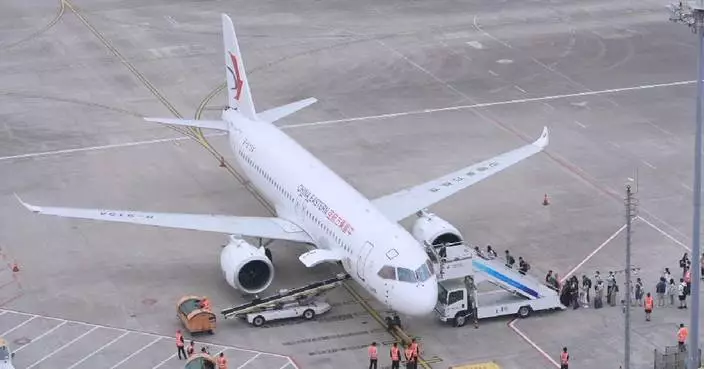Hisor Fortress, 25 kilometers west of the Tajik capital of Dushanbe, offers a glimpse into the country's history and the life of traders more than 2,000 years ago.
Tajikistan is an important stop on the ancient Silk Road, and one of the oldest historical sites in the Central Asian country is Hisor Fortress, which is estimated to be between 2,000 and more than 3,000 years old.
Manizha Bahromzoda, a reporter of Khovar Radio, national information agency of Tajikistan, said the fortress has been conquered by many, making it difficult to pinpoint its specific age.
"It has been destroyed and rebuilt so many times by conquerors who have come and gone: the Greeks, the Mongols, the Arabs, who reconstructed it in their own way. Perhaps some elements were preserved from the previous versions, perhaps not," she said.
Meanwhile, some historians believe that back in the late 2nd century BC, Chinese imperial envoy Zhang Qian had been there during his decade-long mission across Central Asia, trying to initiate transcontinental trade along the Silk Road.
The Tajik reporter elaborated on a historic relic of the ancient trade route.
"This is the relic of a caravanserai. It's a roadside inn where Silk Road traders and their camels could spend their night safely," said Manizha Bahromzoda.

Silk Road traces in Tajikistan's ancient fortress
Autistic children are experiencing a transformation in their lives with the introduction of assistance dogs, which give them not only companionship but also invaluable support.
Xuan Xuan was diagnosed with autism not long after his second birthday. He didn't speak, nor respond to other people.
Autism, also known as Autism Spectrum Disorder (ASD), is a neurological and developmental disorder that affects how people interact with others, communicate, learn, and behave. The prevalence rate of autism among children in China, as reported by the National Health Commission, has reached seven per 1,000 people.
When Xuan Xuan was seven, the boy's condition changed dramatically after dog Harry came to live with the family.
Harry is a three-year-old black Labrador, trained at the Erxing Shanghai Guide and Assistant Dogs School to aid autistic people.
Yu Kai, Xuan Xuan's father, is very gratified after seeing Xuan Xuan's change since Harry came into his life.
"When Xuan Xuan displays stereotyped behaviors, Harry comes and touches him to distract his attention. Xuan Xuan used to immerse himself in playing electronic devices at home, and we had no choice but to allow him to do so. However, since Harry came to our house, Xuan Xuan [has given up playing with electronic devices] and now plays with Harry instead. Sometimes at home, Harry even carries a toy in the mouth to Xuan Xuan to play with," Yu said.
Harry often accompanies Xuan Xuan to his special kindergarten and plays with him after school. Two months after the dog appeared on the scene, Xuan Xuan's mother Gong Minglu saw significant differences in her son.
"When children talk about 'My Little Pony' or 'Ultraman', Xuan Xuan can't participate in the conversation. However, whenever Harry accompanies him to kindergarten, many children circle around to play with him all the time," Gong said.
"Even if he only makes a little progress compared to the day before, we are genuinely happy," she said.
After six to 10 months' training, assistance dogs not only required to master 17 basic commands such as sitting, standing up, and following, but also many advanced commands such as anchoring, deep hugging, and comforting.
While the assistance dogs bring warmth to children with autism, some netizens raise concerns about the dogs' treatment. Some worry that the dogs cannot drink or eat at the proper times when they are serving children.
"At home, if it wants to drink water, it will go to drink water. When it wants to defecate, it will sniff or drag us, letting us know what it wants to do," Gong said.
Some people point out that the children may hurt the dogs. However, Gong argued that parents would stop their children before they really hurt the dogs.
"The child may not be able to control his hand strength when touching the dog, which I admit. At that time, parents should intervene to control both the dogs and the children, and prevent their children from hurting the dog," said Gong.
"Children often can't control their strength and don't really mean to hurt the dog. The dog typically reacts in ways that remind the children to stop their behavior, which has a positive effect on their intervention," said Wang Chunsun, a dog trainer at the Erxing Dogguides.
Each assistance dog would serve a child for eight years. After it retires, the child has the privilege to adopt the dog first.
"The dog can only work for eight years. After it retires, if we want to adopt it, we are first in line. A few years before its service expires, we can apply for another assistance dog for our child," Gong said.
Harry is one of the first batch of professional autism assistance dogs under the "Healing Dogs for Star Children" initiative.
The initiative aims to enhance the lives of families with autistic children by providing specially trained assistance dogs.
The project received support from the Chinese Relief and Development Foundation, Hello the Paw, and Erxing Dogguides, organizations dedicated to rescuing and caring for stray animals as well as training and breeding guide dogs for visually impaired individuals.
"I often check the applications in our system. I see many patients visit our system frequently, expressing their anxiety and worries. They often say that we cannot afford to wait longer as our child is getting older, and the effectiveness of intervention would be weaker," said Chen Qiang, person in charge of the "Healing Dogs for Star Children" initiative.
In Foshan City, south China's Guangdong Province, 12-year-old Lu Lu is waiting for an assistance dog can comfort her.
Lu Lu's grandmother mentioned that without an assistance dog to prevent Lu Lu from wandering away, they sometimes have to tie her with a rope.
"I'm with her all day long, but I still cannot prevent her from wandering away. [One day, when she went missing,] we had to call the police for help. She runs fast, so we have to tie her with a rope because I am old and cannot catch up with her. If she gets a dog, she cannot run away," said Dong Zhihua, Lu Lu's grandmother.
Chen said that Dong is the first batch of applicants for assistance dog, but unfortunately, Lu Lu didn't find a suitable match.
One day, Chen visited Lu Lu with a dog under training named Bao Bao. Although Bao Bao hasn't qualified for the job, the workers of the project want to find whether Bao Bao is a suitable dog for Lu Lu.
Fortunately, Lu Lu and Bao Bao like each other very much. After a couple of months of training, Lu Lu may have a dog that can prevent her from wandering away and provide comfort.
"Even if there is a little hope, we will help Lu Lu to seize it," said Chen.

Autistic children embrace new life with accompany of assistant dog










